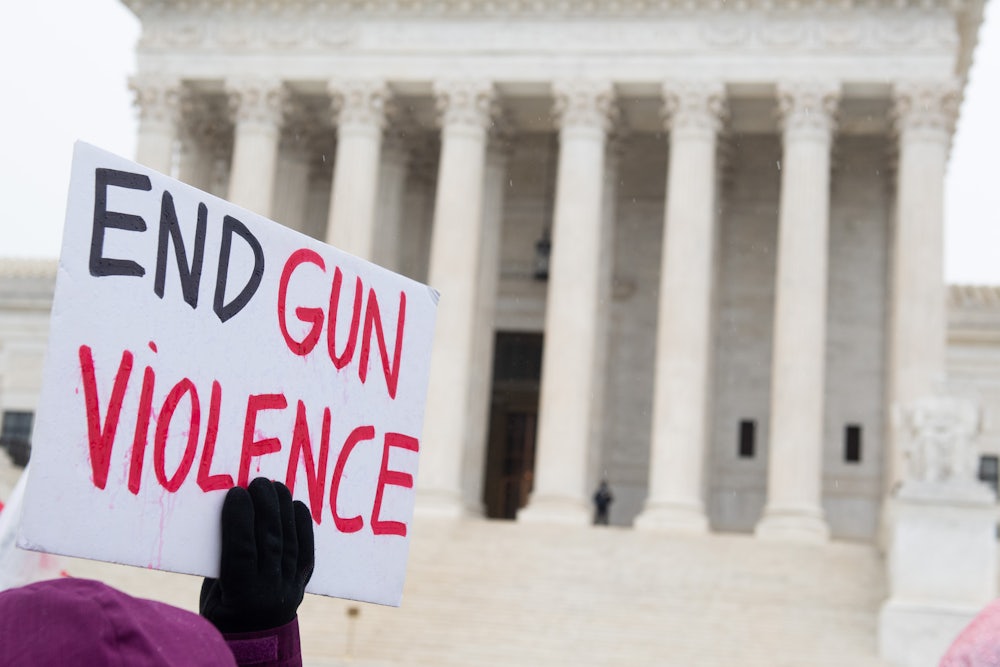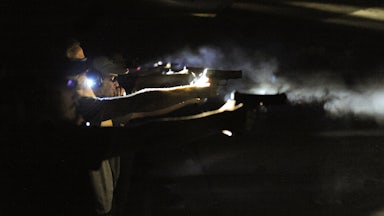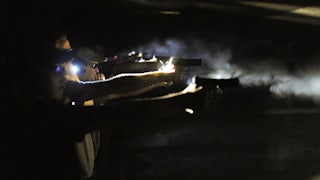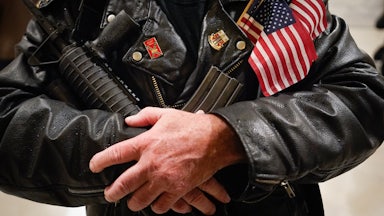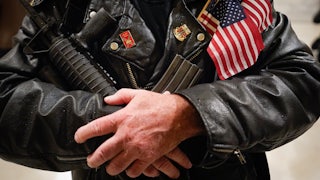The Supreme Court appeared poised to strike down a New York law that tightly restricts who can receive a concealed-carry permit, a move that could broadly reshape the laws governing how firearms are carried in American public spaces. Only about a half-dozen states, including New York, would be directly affected if the justices require less restrictive permit processes. But the court’s ruling could have wider implications for a host of other restrictions that regulate where and when guns can be carried.
The court’s six conservative justices signaled that they were generally sympathetic with the litigants in New York State Pistol and Rifle Association v. Bruen who had tried and failed to obtain a concealed-carry license in the state. “Why isn’t it good enough to say I live in a violent area?” Justice Brett Kavanaugh asked the lawyers during Wednesday’s oral arguments. “How many muggings take place in a forest?” Chief Justice John Roberts asked when questioning the law’s strict enforcement in rural New York.
Bruen’s origins can be traced back to 2008, when the Supreme Court ruled in District of Columbia v. Heller that the Second Amendment protected an individual right to bear arms. The D.C. law in question in Heller severely restricted how a D.C. resident could keep and store a handgun in their own home. As a result, the justices did not address how the Second Amendment now affects laws that limit how people can carry firearms in public. The court later applied its ruling to the rest of the states in McDonald v. Chicago in 2010.
After McDonald, the court did not weigh in on the new bounds of the Second Amendment for the rest of the decade. Why the silence? The justices didn’t say. But most observers suspected that the court’s five-justice conservative bloc was divided on the matter. In recent years, Justice Clarence Thomas began publicly criticizing the other members of the court in dissenting opinions for allegedly avoiding Second Amendment cases, complaining that his colleagues’ inaction had rendered the right to bear arms a “second-class” constitutional right. Shifts in the court’s membership during the Trump era appear to have swung in his favor.
Complicating matters for gun rights advocates is Heller itself. While the 2008 ruling was a landmark victory for their cause, part of the opinion also limited its impact on many existing gun restrictions. Writing for the court toward the end of the opinion, Antonin Scalia cautioned the right to bear arms is “not unlimited” and that “nothing in our opinion should be taken to cast doubt on longstanding prohibitions on the possession of firearms by felons and the mentally ill, or laws forbidding the carrying of firearms in sensitive places such as schools and government buildings, or laws imposing conditions and qualifications on the commercial sale of arms.”
The plaintiffs in Wednesday’s case are two New York residents, Brandon Koch and Robert Nash. The two men previously applied for concealed-carry permits, citing concerns about crime in their area. Local officials denied them a general permit because their reason was considered too speculative to justify granting one under state law. Koch, Nash, and the New York State Rifle and Pistol Association, a local gun rights advocacy group, sued the state to overturn the restrictions. Both the district court and the Second Circuit Court of Appeals sided with New York, leading them to ask the justices to intervene.
In theory, New York issues concealed-carry permits to residents who show “proper cause” to justify the need for one. In practice, the state hands out relatively few permits to ordinary citizens. Since the determination of “proper cause” is often left to local officials, there are also notable disparities in how many permits are granted in each county. And with some exceptions, it’s also a crime in New York to carry a firearm in public without a permit—a consequence that, according to a brief filed by public-defender groups, falls disproportionately on Black and Hispanic New Yorkers.
Gun rights advocates have long criticized the state’s system for effectively denying a constitutional right on what they see as mercurial and unpredictable grounds. They also often point to county officials’ habit of granting licenses to well-connected applicants, a point echoed by some of the justices at oral arguments. “Does it mean that there is the right to self-defense for celebrities and state judges and retired police officers but pretty much not for the kind of ordinary people who have a real, felt need to carry a gun to protect themselves?” Justice Samuel Alito asked Barbara Underwood, the state’s solicitor general.
New York, for its part, argued that its restrictions were justified on public safety grounds. The state also argued that its system passed constitutional muster because the Anglo-American legal tradition often allowed officials to regulate how people could bear arms in public. “New York’s law fits well within that tradition of regulating public carry,” Underwood noted in her opening remarks. “It makes a carry license available to any person not disqualified who has a nonspeculative reason to carry a handgun for self-defense.”
Debates about the Second Amendment tend to be dense on historical reading. In Heller and McDonald, the court’s conservative justices took an originalist approach, drawing upon what they saw as the original public understanding of the right to bear arms at two key points in American history: when the Second Amendment was ratified, shortly after the nation’s founding, and when the Fourteenth Amendment’s passage expanded the Bill of Rights to cover the states after the Civil War. At oral arguments, the parties crossed almost 700 years of history to discuss the Statute of Northampton, a medieval English law passed in 1328 that banned weapons at fairs and other public events.
Underwood told the justices that the statute was the earliest point in an Anglo-American legal tradition that “imposed limits on carrying firearms in public in the interest of public safety.” But Paul Clement, who represented the two men, cautioned the justices against reading too much into the fourteenth-century law. “There just are no reported cases on this side of the Atlantic, not in actual reporters, not in newspaper reports about crimes of the day, that show anybody being prosecuted for a violation of the Northampton crime simply by carrying common firearms for self-defense,” he explained.
But Wednesday’s arguments also dwelled on the practical consequences of the court’s expected ruling. Chief Justice John Roberts and Justice Elena Kagan pressed Clement on whether the right to carry extended to “sensitive locations” like the campuses of Columbia University, NYU, and other New York universities. “Well, NYU doesn’t have much of a campus,” quipped Clement, who then declined to say that such restrictions would be permissible. Justice Amy Coney Barrett asked whether they could be carried in Times Square on New Year’s Eve, to which he said that restrictions might be justified on other grounds. Clement conceded that carrying weapons on the subway might not be permitted, but only, he said, because his clients didn’t live in New York City and were unlikely to use it.
Some of the justices pressed Clement on whether people would be allowed to carry arms while consuming alcohol or at major sporting events. “You think that in New York City people should have considerable freedom to carry concealed weapons,” Justice Stephen Breyer told Clement. “I think that people of good moral character who start drinking a lot and who may be there for a football game or some kind of soccer game can get pretty angry at each other. And if they each have a concealed weapon, who knows?” Clement countered that there isn’t much evidence to support those fears based on other states with less restrictive carry regimes than New York.
Perhaps the most significant question before the justices is how much leeway the courts should give state and local officials when crafting gun-related restrictions in general. Clement urged the court to use strict scrutiny, a shorthand term for the most exacting tier of judicial scrutiny, when weighing Second Amendment restrictions that aren’t rooted in historical tradition. Both Underwood and the federal government urged the court to use intermediate scrutiny, which would be a slightly less formidable hurdle for state and local governments to overcome. How exactly the justices would come down on the level of scrutiny wasn’t clear from oral arguments.
In either event, the Supreme Court appeared set to break new ground on just how far the Second Amendment could be subjected to limitations in public spaces. At one point, Barrett asked Clement about his answer to the Times Square question, which Clement had referred to as a “time, place, and manner restriction”—a term more often found in First Amendment cases. Did Clement mean to suggest that the court should look to that amendment’s “edifices” in Second Amendment cases, Barrett asked?
“I’m suggesting that there is a lot of useful teaching in the First Amendment,” Clement replied. “I’m not sure I’m suggesting you should just take doctrines lock, stock, and barrel from the First Amendment.” But he argued that the court could find some of the protections that the court applies in free speech cases to gun rights cases as well. It wasn’t exactly a ringing endorsement of treating the right to bear arms with the same reverence and protection as the First Amendment, of course. But it was a leap forward from the “second-class” status that Thomas had lamented only a few years earlier. The court’s ruling is expected before the end of its term next summer.
